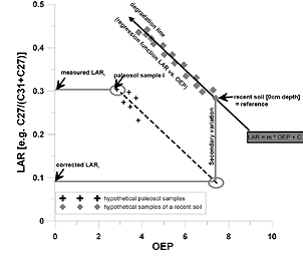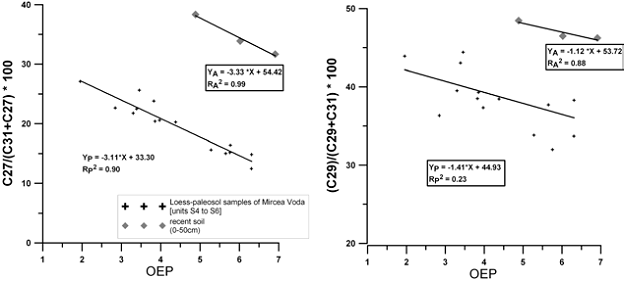LOESSFEST'09 | Aug. 31st – Sept. 3rd, 2009 |Novi Sad-Serbia
A Correction Procedure for the Degradation Effect on N-Alkane Ratios
Buggle, B.1, Glaser, B.1
1Department of Soil Physics, University of Bayreuth, Universitätsstr. 30, D-95440 Bayreuth, Germany
Introduction
N-Alkanes are important compounds of epicuticular plant waxes. Due to characteristic distribution patterns, n-alkanes are used for the chemotaxonomic differentiation of plant types. This compound class is generally regarded as relative recalcitrant. Hence, long chain n-alkane ratios LARs (e.g. n-C27 vs. n-C31, n-C29 vs. n-C31 etc.) are widely applied in paleoenvironmental studies to reconstruct changes in paleovegetation such as variations in the relative abundance of tree vs. grass vegetation. Also in loess-paleosol sequences n-alkane biomarker potentially represent valuable biomarkers for different types of vegetation (e.g. see corresponding abstract of Buggle et al.). Though it is known from recent depth profiles and incubation experiment that alkane pattern may change in course of degradation, in most paleoenvironmental applications such degradation effects are not taken into account. Here, we present an approach of how to correct n-alkane ratios of fossil soils for degradation effect.
The approach - rational
As proxy of n-alkane degradation the odd over even predominance (as measured by the OEP or CPI Index) of the n-Alkane distribution is widely accepted. Studies on recent soil depth profiles show that the OEP is decreasing with soil depth and LARs covary with the OEP. Similar patterns have been also reported from paleosol, suggesting that these trends reflect changes of n-alkane pattern with increasing degradation. The principle of the proposed correction procedure is to use characteristic correlation and regression function between LARs and OEP derived from recent soil to correct n-alkane patterns from paleosols or loess-paleosol sequences for degradation effects. In literature different kinds of effects have been suggested to be most prominent during n-alkane degradation in soils (e.g. preferential removal of short chain homologues, preferential removal of the most abundant homologues, contribution of microbial derived n-alkanes with low OEP). However regardless of the actual mechanism, the regression lines of OEP vs. LARs should always describe the impact of degradation on LARs, empirically. Nevertheless, OEP changes theoretically could be also related to certain changes in paleovegetation. However, this issue can be independently evaluated by comparison with the Alk > C25/Alk < C25 ratio or other proxies of microbial reworking, organic matter degradation, mineralization and weathering.
The procedure – case example loess-paleosol sequence Mircea Voda
- Setting up the regression function OEP vs. LAR for
the recent soil (degradation line)
LAR0 = m0 × OEP0 + C0
Note for different kind of predominances e.g. C27 over C31 and C31 over C27 separate degradation lines have to be determined by sampling suitable recent soil. - Calculating the corrected LAR of a paleosol sample
via the slope of the degradation line:
LARcorr = LARmeasured + m0 × ΔOEP
Corrected in this sense refers to the theoretical LAR for the same degradation intensity (i.e. OEP value) as the reference sample. As reference sample we choose the uppermost sample of the recent topsoil, since the vegetation type under which its alkane pattern developed should be known best. - Evaluation with other degradation or weathering proxies (e.g. Alk > C25/Alk < C25 ratio)

Fig.1. Schematic sketch illustrating the approach to correct
fossil LARs (as for example the C27/C27+C31 ratio) for degradation
effect. Data points for the recent soil and paleosols
are just hypothetical. The regression line of the OEP – used
as degradation proxy – versus LAR for the recent soil, is
proposed to describe the degradation effect on LARs and
is therefore regarded as “degradation line”. Assuming that
the slope m of the degradation line for the paleosol samples
is similar to the recent soil, it is possible to reconstruct the
corrected LAR for the sample by parallel displacement of the
degradation line. As corrected LAR we regard the hypothetical
LAR of a “paleo-sample” with the same intensity of degradation
(i.e. same OEP) as the recent topsoil. The distance of
the parallel displacement is regarded as secondary variation
with respect to the degradation line of the recent soil. We
propose that these secondary variations reflect variations in
initial LAR (here C27/(C27+C31)) of the fossil organic matter,
indicating changes in the paleovegetation. Accordingly,
samples plotting on the same degradation line would derive
from material with similar initial LAR. For samples with
inverse LAR predominance (e.g. C27 over C31) a separate
degradation line has to be determined in a similar way.
Case example loess-paleosol sequence Mircea Voda
The regression lines LAR vs. OEP are similar for both recent soil and paleosol samples, supporting our approach to use the regression line of the recent soil to correct the paleosol samples. The difference in the intercept of the regression line for the paleosols and the recent soil is regarded as secondary variation to the degradation line of the recent soil can be interpreted paleoecologically. The good correlation coefficient of the paleosol samples indicates that changes in C27/(C27+C31) between the loess paleosol units S4, S5, S6, L5, and L6 are mainly caused by degradation effects and not by changes in paleovegetation. In contrary the low correlation coefficient for C29/(C29+C31) and the large scatter of the data around the LAR ~ OEP regression line suggests that this ratio strongly reflects changes in paleovegetation. As we presented in the corresponding abstract of Buggle et al., it is possible to extract this paleoecological meaningful information by applying the proposed correction procedure.

Fig.2. C27/(C27+C31) *100 vs. OEP and C29/(C29+C31)*100 vs. OEP crossplot for samples from the recent soil (Chernozem) of the Mircea Voda site and for the loess-paleosol samples of the units S4 to S6 of the Mircea Voda section. Index A refers to the data
from the recent soil, Index P to the fossil n-alkane data.



